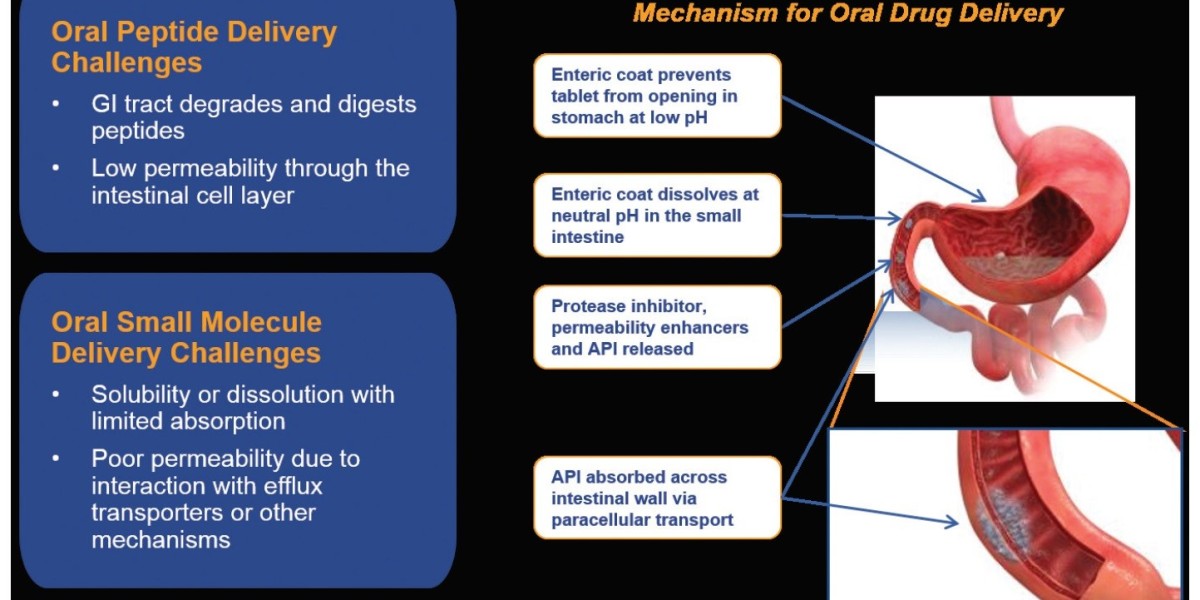What Are the Main Barriers to Effective Oral Peptide Drug Delivery?
One of the most significant challenges in the oral delivery of peptides is their instability in the gastrointestinal (GI) tract. Peptides, such as insulin and calcitonin, are prone to degradation by stomach enzymes and struggle to penetrate the intestinal epithelium. The human gut's role in digestion and immunity creates physiological barriers that hinder the absorption of these therapeutic peptides. Due to this, most peptides have been traditionally administered via injections
.
However, recent innovations are addressing these issues. New technologies such as nanoparticle encapsulation and lipid-based drug delivery systems are making progress in protecting peptides from enzymatic degradation. For example, Mucoadhesive polymers and permeation enhancers improve peptide absorption in the small intestine by increasing membrane permeability
. These technologies hold promise for making oral peptide therapy more effective and accessible to patients.
2. How Has Oral Insulin Therapy Improved Over Recent Years?
The oral administration of insulin is a groundbreaking advancement in diabetes treatment, potentially offering a more convenient alternative to injections. One of the top innovations is the use of advanced encapsulation technologies, which protect insulin from digestive enzymes and improve its bioavailability. Companies like Novo Nordisk are leading this space by developing orally administered insulin therapies that target specific areas of the gut to enhance absorption
.
Recent clinical trials have shown significant improvements in glycemic control for patients using oral insulin formulations. Additionally, prodrug approaches, which convert the peptide into an inactive form until it reaches the target site, are also being explored. These technologies are expected to increase patient adherence and make insulin administration less invasive and more routine
.
3. What Oral Peptide Formulations Are Available for Treating Digestive and Gastric Disorders?
Peptides like plecanatide and linaclotide are effective treatments for gastric and digestive disorders, including chronic idiopathic constipation and irritable bowel syndrome. These peptides mimic naturally occurring human peptides to stimulate fluid secretion in the intestines, improving bowel movements and easing symptoms. Linaclotide, for example, targets the guanylate cyclase-C receptor, resulting in increased intestinal fluid secretion and reduced visceral pain
.
Advancements in oral peptide coatings have further improved the delivery of these formulations, protecting them from the harsh acidic environment of the stomach. With the introduction of pH-sensitive coatings and time-release capsules, these treatments are becoming more effective, targeting the digestive system precisely where they are needed without being prematurely degraded
.
4. How Effective Are Oral Calcitonin Peptides for Treating Bone Diseases?
Calcitonin peptides, which help regulate calcium levels and bone metabolism, are a promising treatment for bone-related disorders such as osteoporosis. Traditionally administered by injection, calcitonin has been developed into an oral form using innovative drug delivery systems. Alkermes and AstraZeneca are at the forefront of this technology, employing advanced permeation enhancers to improve calcitonin absorption in the gut
.
New developments in oral peptide gel technology have also enhanced the efficacy of calcitonin. These gels form protective barriers in the stomach, allowing the peptide to be absorbed more efficiently. This shift to oral administration could revolutionize the treatment of bone diseases, making long-term treatment more manageable for patients who would otherwise rely on injections
.
Top New Technologies and Innovations in Oral Peptides
Several cutting-edge technologies are shaping the future of oral peptide and protein delivery:
Nanoparticles: Small particles encapsulating peptides, protecting them from enzymatic degradation and enhancing permeability.
Permeation Enhancers: Substances that improve the permeability of the intestinal lining, allowing for better absorption of peptides.
Prodrugs: Peptides are converted into inactive forms that become active once they reach their target area in the GI tract.
Mucoadhesive Polymers: These adhere to mucosal surfaces in the gut, extending the residence time of peptides in the absorption zone.
More info . MarketResearchFuture
Related report
breath analyzer market active adult community market high tibial osteotomy plate market










